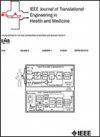从异常呼吸模式评估心脏损伤:来自无线雷达和深度学习研究的见解
IF 4.4
3区 医学
Q2 ENGINEERING, BIOMEDICAL
IEEE Journal of Translational Engineering in Health and Medicine-Jtehm
Pub Date : 2025-07-14
DOI:10.1109/JTEHM.2025.3588523
引用次数: 0
摘要
目的:评估心功能损害和睡眠呼吸障碍的双向影响仍未得到充分研究。因此,本研究从无线雷达框架分析了呼吸模式,以探索其与超声心动图(2d回声)测量的关系。方法:收集台湾北部某心脏科病房患者的背景资料、二维回声参数及生化资料。他们在2d回波的前一天晚上和晚上获得基于雷达的呼吸模式,并进行平均,并用于得出呼吸障碍指数(RDI)和周期性呼吸(PB)周期长度等指标,代表整体呼吸模式。接下来,根据50%的左室射血分数(LVEF)阈值对检索到的数据进行分组,并使用均值比较和回归模型进行分析,以探索关系。结果:与LVEF为50%的患者相比,LVEF为50%的患者表现出明显减少的总睡眠时间,更高的RDI和更长的PB周期。RDI每增加1个事件/小时,LVEF降低0.22%(95%置信区间[CI]: - 0.41%至- 0.03%,从50%至50%降低50%。亚组分析显示,PB周期长度与n端激素原-脑钠尿肽(NT-proBNP)水平升高有关。结论:本研究表明,结合深度学习的无线雷达框架可以有效地监测与心功能相关的呼吸模式。它的非接触式特性可能支持持续的心功能评估。临床影响:本研究强调了无线雷达和深度学习框架在监测与心功能(如LVEF)相关的呼吸模式方面的有效性,强调了其长期心脏和睡眠障碍管理的潜力。本文章由计算机程序翻译,如有差异,请以英文原文为准。
Evaluating Cardiac Impairment From Abnormal Respiratory Patterns: Insights From a Wireless Radar and Deep Learning Study
Objectives: Assessing the bidirectional impacts of heart function impairment and sleep-disordered breathing remains underexplored. Thus, this study analyzed respiratory patterns from a wireless radar framework to explore their associations with echocardiographic (2D-echo) measurements. Methods: Background details, 2D-echo parameters, and biochemical data were collected from patients in a cardiology ward in northern Taiwan. Their radar-based respiratory patterns from the night before and the night of the 2D-echo were obtained, averaged, and used to derive indices such as the respiratory disturbance index (RDI) and periodic breathing (PB) cycle length, representing overall respiratory patterns. Next, retrieved data were grouped based on a 50% left ventricular ejection fraction (LVEF) threshold and analyzed using mean comparisons and regression models to explore relationships. Results: Patients with an LVEF of $\le 50$ % demonstrated significantly reduced total sleep time, higher RDI, and longer PB cycles compared to those with LVEF >50%. Each 1-event/h increase in the RDI reduced the LVEF by 0.22% (95% confidence interval [CI]: −0.41% to −0.03%, p <0.05),> $\le 50$ % from >50%. Subgroup analysis revealed that the PB cycle length was associated with elevated N-terminal-prohormone-brain-natriuretic-peptide (NT-proBNP) levels. Conclusions: This study demonstrates that a wireless radar framework combined with deep learning can effectively monitor respiratory patterns that are associated with cardiac function. Its contactless nature may support continuous cardiac function assessments. Clinical Impact: This study highlights the effectiveness of a wireless radar and deep learning framework for monitoring respiratory patterns that are associated with cardiac function (e.g., LVEF), underscoring its potential for long-term cardiac and sleep-disorder management.
求助全文
通过发布文献求助,成功后即可免费获取论文全文。
去求助
来源期刊

IEEE Journal of Translational Engineering in Health and Medicine-Jtehm
Engineering-Biomedical Engineering
CiteScore
7.40
自引率
2.90%
发文量
65
审稿时长
27 weeks
期刊介绍:
The IEEE Journal of Translational Engineering in Health and Medicine is an open access product that bridges the engineering and clinical worlds, focusing on detailed descriptions of advanced technical solutions to a clinical need along with clinical results and healthcare relevance. The journal provides a platform for state-of-the-art technology directions in the interdisciplinary field of biomedical engineering, embracing engineering, life sciences and medicine. A unique aspect of the journal is its ability to foster a collaboration between physicians and engineers for presenting broad and compelling real world technological and engineering solutions that can be implemented in the interest of improving quality of patient care and treatment outcomes, thereby reducing costs and improving efficiency. The journal provides an active forum for clinical research and relevant state-of the-art technology for members of all the IEEE societies that have an interest in biomedical engineering as well as reaching out directly to physicians and the medical community through the American Medical Association (AMA) and other clinical societies. The scope of the journal includes, but is not limited, to topics on: Medical devices, healthcare delivery systems, global healthcare initiatives, and ICT based services; Technological relevance to healthcare cost reduction; Technology affecting healthcare management, decision-making, and policy; Advanced technical work that is applied to solving specific clinical needs.
 求助内容:
求助内容: 应助结果提醒方式:
应助结果提醒方式:


